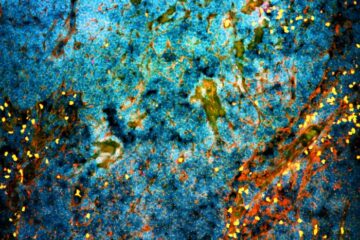
Predicting the future: A long-term study has shown a common bone density scan can also show calcified plaque build-up in the abdominal aorta – revealing if someone is at increased…

Therapy sensitivity in prostate cancer halted by protein regulating circadian rhythm. Hormone therapy is successful at keeping metastatic prostate cancer under control, but eventually the tumor cells become resistant to…

Earth of billions of years ago illuminated by light-capturing proteins. Using light-capturing proteins in living microbes, scientists have reconstructed what life was like for some of Earth’s earliest organisms. These…

Research team led by Göttingen University combine two techniques to achieve isotropic super-resolution imaging. Over the last two decades, microscopy has seen unprecedented advances in speed and resolution. However, cellular…

Communication networks need nodes at which information is processed or rerouted. Physicists at the University of Basel have now developed a network node for quantum communication networks that can store…

University of Tübingen research team uses properties of quartz in sediments to study sedi-mentary cycles and climate dynamics. Global warming and a progressively drier climate in many parts of the…

Unusual magnetically driven vortices may be generating Earth-size concentrations of hydrocarbon haze. While Jupiter’s Great Red Spot has been a constant feature of the planet for centuries, University of California,…

Scientists from the H.E.S.S. collaboration including a consortium of German universities, the Max-Planck-Institut für Kernphysik and the CNRS in France have recently identified electrons and positrons with the highest energies…

Scientists at the European XFEL and DESY produce high-power attosecond X-ray pulses at megahertz repetition rates. Publication in Nature Photonics. A research team at European XFEL and DESY has achieved…

New insights into how checkpoint inhibitors affect the immune system could improve cancer treatment. A multinational collaboration co-led by the Garvan Institute of Medical Research has uncovered a potential explanation…

University of Wisconsin–Madison biochemists have developed a new, efficient method that may give first responders, environmental monitoring groups, or even you, the ability to quickly detect harmful and health-relevant substances…

Constant ‘churn’ of new cancer cells gives the disease ample room for evolutionary innovation, according to a study in the journal eLIFE. Researchers at the University of Cologne and the…

Electrically defined quantum dots in zinc oxide. Researchers have successfully created electrically defined quantum dots in zinc oxide (ZnO) heterostructures, marking a significant milestone in the development of quantum technologies….

Using energy- and resource-saving methods, a research team at the Institute of Inorganic Chemistry at TU Graz aims to produce high-quality doped silicon layers for the electronics and solar industries….

A large number of 2D materials like graphene can have nanopores – small holes formed by missing atoms through which foreign substances can pass. The properties of these nanopores dictate many…

New deep learning architecture enables higher efficiency. It is the computational processing of images that reveals the finest details of a sample placed under all kinds of different light microscopes….

Humans and animals move with remarkable economy without consciously thinking about it by utilizing the natural oscillation patterns of their bodies. A new tool developed by researchers at the Technical…

AI-enhanced metalenses achieve high-resolution, full-color imaging for compact optical systems. Modern imaging systems, such as those used in smartphones, virtual reality (VR), and augmented reality (AR) devices, are constantly evolving…